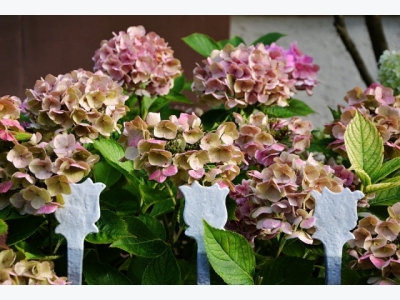Simple Garden Fences

You have probably heard the adage that good fences make good neighbors. That’s true not just between people but also between our gardens and the forces that can damage them or lessen our pleasure of them.
Whether the threat is from animals such as deer, rabbits, dogs, chickens, or groundhogs; neighbors; or the natural elements of wind and sun, our gardens need protection.
How you protect your garden depends on what you are protecting it from.
Keeping Animals Out
Every year for a number of years deer ate my Brussels sprouts just before I was ready to harvest them. I was willing to share, but the deer nibbled those sweet sprouts down to the stalks. Some years, groundhogs fed their growing families from my garden.
Most years, my dogs ran roughshod over the beds of newly sown vegetables, and the cats dug wherever they wanted. Finally I said, “No more Mister Nice Guy,” and determined to put up a fence.
A serious deer fence needs to be six feet high. To keep out cats and small dogs the fence has to be fastened to the ground. And to deter the groundhogs, fences must reach three to four feet above ground and one foot below, bent at a 90-degree angle and extending an additional eight to twelve inches away from the garden.
You can fence out many of the animal pests out with chicken wire fencing stretched between cedar posts. Consider adding a two-wire electric fence for added protection.
Shelter from the Elements
For a natural windscreen, plant staggered rows of evergreens and deciduous trees and shrubs upwind from your garden. Chain-link fences with bamboo screening or fabric slats are low maintenance and effective wind barriers. Wood fencing is an attractive alternative to chain-link; just make sure it extends at least two feet into the ground so the wind won’t blow it over.
If you live in a hot and sunny part of the world your garden may need protection from the sun. You can fashion canvas or synthetic shades that you can roll up and unroll as needed to protect plants from the hot sun. For more permanent protection consider installing a trellis above the parts of the garden that need shade.
Decorative and Privacy Fencing
Hedges make great privacy fences. A trimmed hedge of one type of plant looks fairly formal, while a free-form mixture creates a more relaxed and natural effect. Boxwood, holly, yews, and lilac are some of the many excellent hedge plants; just be sure to choose plants that grow well in your location.
If you don’t have time for hedges to grow or have limited space, wood panel fences may be the perfect privacy solution. With small panels, they are easy for do-it-yourselfers to put in place.
Sometimes you just want a little privacy, but don’t need to block the view entirely. Decorative wrought iron and wooden picket fences give a sense of privacy while enhancing the look and feel of the garden. Creative gardeners have made decorative fences from bunches of twigs, grape vines, pliable stems of young alders, and other natural materials.
Có thể bạn quan tâm
Phần mềm

Phối trộn thức ăn chăn nuôi

Pha dung dịch thủy canh

Định mức cho tôm ăn

Phối trộn phân bón NPK

Xác định tỷ lệ tôm sống

Chuyển đổi đơn vị phân bón

Xác định công suất sục khí

Chuyển đổi đơn vị tôm

Tính diện tích nhà kính

Tính thể tích ao hồ



 How to Grow Flowers: The Ultimate Guide
How to Grow Flowers: The Ultimate Guide  Revitalizing Cheap Plants
Revitalizing Cheap Plants